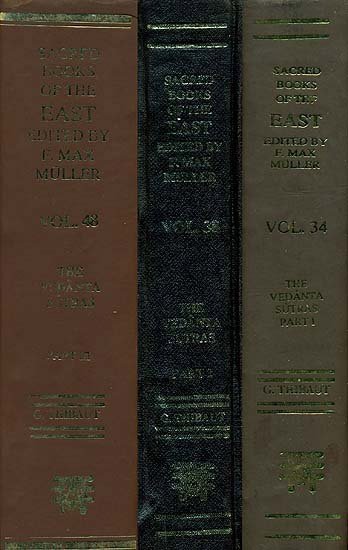Brahma Sutras (Ramanuja)
by George Thibaut | 1904 | 275,953 words | ISBN-10: 8120801350 | ISBN-13: 9788120801356
The English translation of the Brahma Sutras (also, Vedanta Sutras) with commentary by Ramanuja (known as the Sri Bhasya). The Brahmasutra expounds the essential philosophy of the Upanishads which, primarily revolving around the knowledge of Brahman and Atman, represents the foundation of Vedanta. Ramanjua’s interpretation of these sutras from a V...
Sutra 1.2.27
27. Should it be said that it is not so, on account of the word, etc., and on account of the abiding within; we say, no; on account of meditation being taught thus, on account of impossibility; and because they read of him as person.
An objection is raised. Vaiśvānara cannot be ascertained to be the highest Self, because, on the account of the text and of the abiding within, we can understand by the Vaiśvānara in our text the intestinal fire also. The text to which we refer occurs in the Vaiśvānara-vidyā of the Vājasaneyins, 'This one is the Agni Vaiśvānara,' where the two words 'Agni' and 'Vaiśvānara' are exhibited in co-ordination. And in the section under discussion the passage, 'the heart is the Gārhapatya fire, the mind the Anvāhārya-pacana fire, the mouth the Āhavanīya fire' (Ch. Up. V, 18, 2), represents the Vaiśvānara in so far as abiding within the heart and so on as constituting the triad of sacred fires. Moreover the text, 'The first food which a man may take is in the place of Soma. And he who offers that first oblation should offer it to Prāṇa' (V, 19, 1), intimates that Vaiśvānara is the abode of the offering to Prāṇa. In the same way the Vājasaneyins declare that Vaiśvānara abides within man, viz. in the passage 'He who knows this Agni Vaiśvānara shaped like a man abiding within man.' As thus Vaiśvānara appears in co-ordination with the word 'Agni,' is represented as the triad of sacred fires, is said to be the abode of the oblation to Breath, and to abide within man, he must be viewed as the intestinal fire, and it is therefore not true that he can be identified with the highest Self only.
This objection is set aside by the Sūtra. It is not so 'on account of meditation (on the highest Self) being taught thus,' i.e. as the text means to teach that the highest Brahman which, in the manner described before, has the three worlds for its body should be meditated upon as qualified by the intestinal fire which (like other beings) constitutes Brahman’s body. For the word 'Agni' denotes not only the intestinal fire, but also the highest Self in so far as qualified by the intestinal fire.—But how is this to be known?—'On account of impossibility;' i.e. because it is impossible that the mere intestinal fire should have the three worlds for its body. The true state of the case therefore is that the word Agni, which is understood to denote the intestinal fire, when appearing in co-ordination with the term Vaiśvānara represented as having the three worlds for his body, denotes (not the intestinal fire, but) the highest Self as qualified by that fire viewed as forming the body of the Self. Thus the Lord also says, 'As Vaiśvānara fire I abide in the body of living creatures and, being assisted by breath inspired and expired, digest the fourfold food' (Bha Gī. XIV, 15). 'As Vaiśvānara fire' here means 'embodied in the intestinal fire.'—The Chāndogya text under discussion enjoins meditation on the highest Self embodied in the Vaiśvānara fire.—Moreover the Vājasaneyins read of him, viz. the Vaiśvānara, as man or person, viz. in the passage 'That Agni Vaiśvānara is the person' (Sa. Brā. X, 6, 1, 11). The intestinal fire by itself cannot be called a person; unconditioned personality belongs to the highest Self only. Compare 'the thousand-headed person' (Ṛ. Saṃh.), and 'the Person is all this' (Śve. Up. III, 15).
